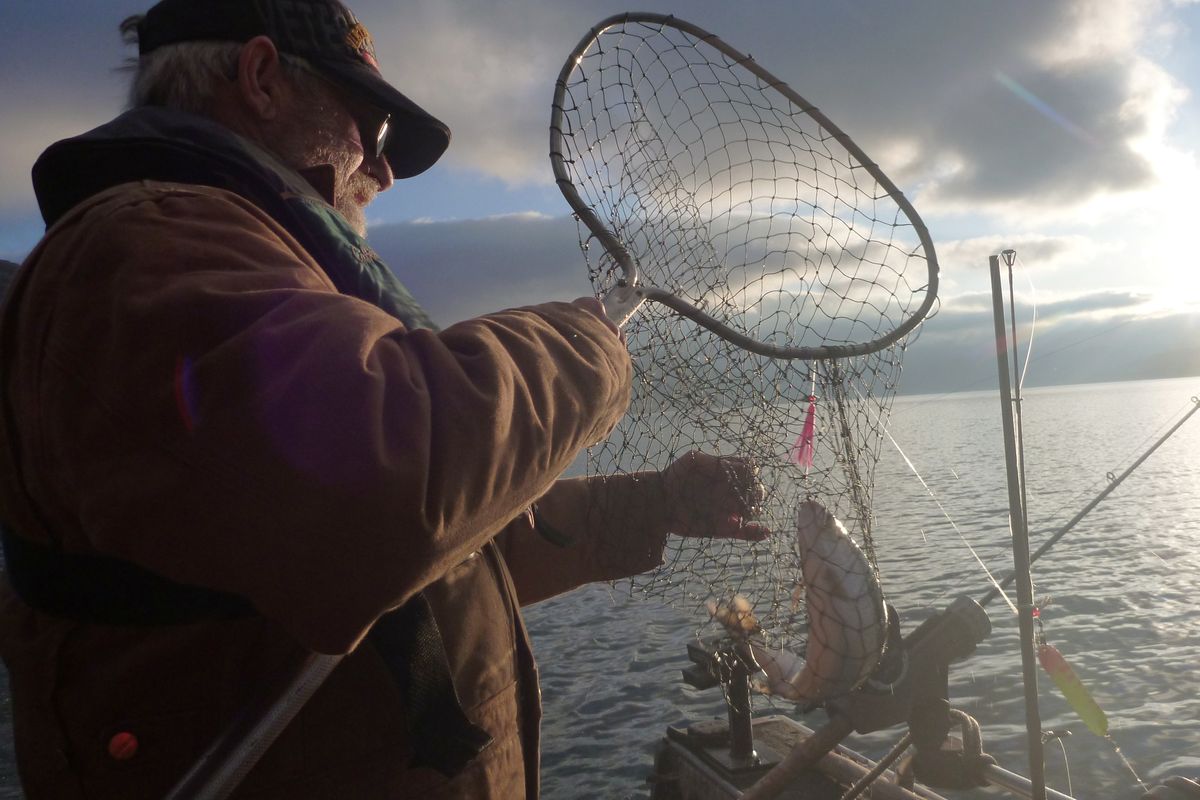Wild redband trout could disappear without protection

Wild redband trout in Lake Roosevelt need more distinction to survive, researchers say.
Without a little more protection, the native redbands could disappear from the fishery dominated by the abundant hatchery-produced rainbow trout released in the Columbia River reservoir each year.
The Columbia River redband rainbow trout is a native fish found in the Columbia and its tributaries in Washington, Idaho, Montana and Oregon. It is genetically different from the “coastal” rainbow stock produced at the region’s hatcheries, said Holly McLellan, a fisheries biologist with the Colville Tribe.
Redbands are found in 27 percent of their original range, including the waters upstream from Grand Coulee Dam.
State and tribal fish managers are exploring rule changes to reduce the number of these wild trout killed by anglers in Lake Roosevelt.
“We want to encourage harvest of hatchery trout while protecting more wild trout,” said McLellan, one of several researchers studying Lake Roosevelt fisheries. Co-management projects on the reservoir involving the Colvilles, the Spokane Tribe and the Washington Department of Fish and Wildlife.
The daily trout fishing limit on Roosevelt is five fish, only two of which can be longer than 20 inches. Anglers do not have to distinguish between wild redbands and fin-clipped triploid rainbows.
The wild redbands spawn in the Roosevelt tributaries, primarily the Sanpoil River. The sterile triploids produced in fish hatcheries can be distinguished by the missing adipose fins, which are clipped before the fish are released into the reservoir.
Lake Roosevelt is popular with a range of sport fishermen who pursue species such as walleyes, smallmouth bass, burbot, trout and kokanee.
“But rainbow trout are the most-targeted fish,” McLellan said.
Of the 44,836 angler trips on Roosevelt in 2009, a study found 55 to 60 percent of the anglers targeted rainbow trout. The rate increased in the lower reservoir to 73 percent.
More than 90 percent of the rainbows harvested are caught in the lower reservoir from the Lincoln area downstream to Grand Coulee Dam, she said.
Of the overall trout harvest, more than 20 percent is wild fish, primarily in the 15-18 inch range, she said.
“We need to reduce the number of wild redbands being harvested” to protect the historic gene pool that contains local adaptations for the Upper Columbia River, she said.
Surveys show that 75 percent of trout anglers keep one wild redband per trip, while some anglers keep two to five wild trout a trip, especially from January through April.
“We need to ensure that more wild trout have at least one opportunity to spawn prior to being harvested,” McLellan said.
Options include allowing anglers to keep more than five fin-clipped hatchery trout while limiting them to retaining no more than one or two unmarked wild trout.
If the limit was changed to allow only one wild trout, the harvest of native redbands would be reduced by 25 percent, she said.
Recent genetics work and electronic tagging studies have verified that 2-3 percent of the wild redbands hatched in Lake Roosevelt tributaries are anadromous – that is, they’re life histories prompt them as juveniles to head downstream to the ocean.
“These fish are considered steelhead,” McLellan said. “The redbands that stay in freshwater are called resident fish.”
Because of dam blockages, the ocean-going redbands can’t return as adults to spawn in Lake Roosevelt tributaries as the residents do.
The hatchery trout program lures most anglers to Lake Roosevelt.
Up to 750,000 triploid rainbows are being raised to catchable sizes each year in 63 net pens along the lake. The fish are fin-clipped and released in spring through a dam-impact mitigation project funded by the Bonneville Power Administration.
The Spokane Tribal Hatchery has been shifting its emphasis from kokanee to producing more triploid rainbows that are being fin-clipped and released into Roosevelt.
But the Spokane Tribe is trying to fill a different niche, said Tim Peone, hatchery manager.
“Net pens don’t work in the Spokane Arm because of the high gas levels caused by Little Falls and Long Lake dams,” he said.
So the Spokane Tribe’s rainbows are being raised at the hatchery and then released into the Spokane Arm to improve fishing in that portion of the reservoir for tribal and non-tribal anglers.
Getting more wild redbands to survive goes beyond reducing their harvest by anglers and increasing production of hatchery fish, researchers say.
The Colville Tribe spends $1 million a year of its federal mitigation money on redband trout restoration projects that include fixing culverts to make them fish friendly, fencing to keep cows out of key tributaries, bank stability projects and riparian habitat planting.
The Sanpoil River, which is key to redband spawning, gets special attention.
Researchers estimate about 5,000 spawning pairs of redbands enter the Sanpoil River compared with fewer than 200 in any of the other Roosevelt tributaries.
The Sanpoil spawners produce about 30,000 juveniles, mostly 1 year old, that survive to out-migrate from the Sanpoil River every spring.
However, studies found that more than half of the 1-year old fish were being eaten by walleyes and smallmouth bass in the bottleneck where the river flows into the Sanpoil Arm of Lake Roosevelt
Tribal researchers are still evaluating the success of several years of netting predator fish that concentrate at the bottleneck during the period the young redband trout are migrating downstream.
“The predator populations tend to quickly rebound,” McLellan said. “It’s that small window of outmigration that concerns us.”
The next major foe the Sanpoil redbands face is sport fishing.
About 75 percent of the wild redbands harvested by anglers are of Sanpoil origin, genetics studies indicate. That pressure on Sanpoil natives must be reduced to maintain sustainability, researchers say.
Fish managers are gradually working to improve trout habitat in other Roosevelt tributaries, many of which are underused by wild redbands, McLellan said.
“The redbands will find the habitat if it’s good quality,” she said, “but only if there are enough wild fish.”